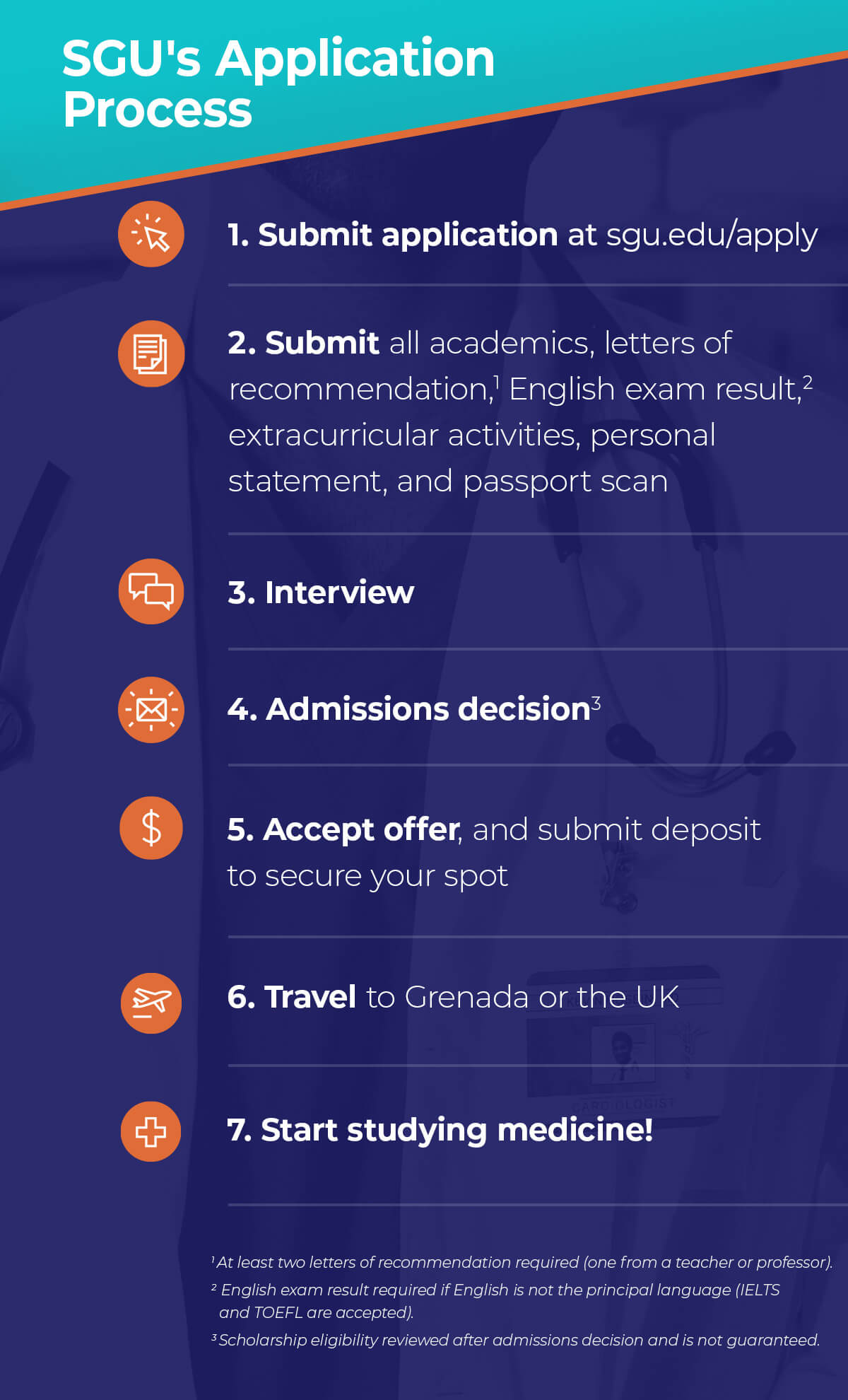Many students from around the world are interested in becoming a doctor in the United States. According to Results and Data: 2020 Main Residency Match from the National Resident Matching Program (NRMP), more than 5,800 international medical graduates (IMGs) who are citizens of other countries obtained US residencies in 2024.
For a non-US citizen, gaining residency in the United States is possible. Review these steps carefully to help set you on a path that reaches your end goal.
7 Essential steps to become a doctor in the US
While some international students pursue medical school in the US because they ultimately want to practice in the United States, it’s wise to research and consider a wider range of options. St. George’s University (SGU), located in the Caribbean, can help give students from all over the world the opportunity to practice at different locations, including the United States.
1. Apply to medical school
Medical degrees differ throughout the world, but a Doctor of Medicine (MD) or Doctor of Osteopathic Medicine (DO) are the most common degrees for doctors. When comparing medical schools that offer these degree programs, make sure to evaluate whether you meet program eligibility requirements. American medical schools that accept international students often have very specific requirements.
For example, many schools require an English language test like the International English Language Testing System (IELTS) exam to ensure that international students are prepared to study and practice medicine in English.
Students who didn’t earn a US bachelor’s degree may find that MD programs with multiple entry points, like SGU, can be a better fit. For example, SGU has a range of entry points for the Doctor of Medicine program to accommodate applicants of all educational systems and backgrounds. This allows students entering their first term of basic sciences to feel prepared to begin their MD program by supplementing their knowledge with preclinical instruction.
When it comes to choosing a program, be sure to identify schools that have strong graduate outcomes. Student data from the last five years shows that 88 percent of international graduates of the SGU School of Medicine secured a US residency.* It’s also wise to ask medical schools about what support services they have to ensure students are successful.
2. Attend medical school, and begin the licensure process
Depending on the program you choose, your first year or two of classes might entail completing preclinical courses that establish the scientific knowledge base you’ll need for your dedicated medical classes. Once you begin the four-year MD program, you’ll spend two years attending lectures, completing lab sessions, and working in small groups. Students should also plan to take the United States Medical Licensing Examination (USMLE) Step 1 soon after completing their second year as an MD student.
The final two years of medical school are when students complete clinical rotations to further develop their practical skills and professionalism. Experienced physicians oversee students and their progress, and they can often be valuable mentors. Sometime during these final two years, you will also need to pass the USMLE Step 2 Clinical Knowledge (CK) examination.
3. Address additional requirements for obtaining a residency
Students who graduate from a school outside the United State will eventually need to obtain certification from the Educational Commission for Foreign Medical Graduates (ECFMG) to practice and apply for residency. Obtaining certification from the ECFMG is essential for becoming a physician in the US, so students should identify the appropriate pathways> through which they should apply for certification.
You must meet this requirement to apply for US residency positions through the Electronic Residency Application Service (ERAS). Obtaining ECFMG certification is very simple—just submit an application, USMLE scores, and a few other documents for verification. Plan to complete this step during the third year of your MD program.
4. Apply for residency positions
Once you complete medical school, the next step to practice in the US is starting residency. Medical students need to begin working on residency application materials, such as gathering letters of recommendation and writing a residency personal statement, near the end of the third year of their MD program.
Here are some elements of the Match process specific to international students that they should be aware of:
- It’s essential to research programs you’re interested in to ensure the programs are willing to provide either H-1B or J-1 visa sponsorship.
- While a J-1 visa requires the graduate to return to their home country for two years upon completing their training, it’s also possible to obtain a waiver through an option like the Conrad 30 waiver program.
- The Electronic Residency Application Service (ERAS) timeline platform becomes available for international students in late spring and opens for submissions in the fall. Try to apply as early as possible because residency programs offer interviews on a rolling basis.
The next step is compiling a rank order list, which should include every program that interviewed you, and then submitting it through the National Resident Matching Program (NRMP). Students discover if they matched into residency and where they will complete their training in March, which is referred to as “Match Week.” Read on for a fuller breakdown of the Match process.
5. Complete a postgraduate training program
Depending on the specialty, residency can last between three and seven years. During this postgraduate training, graduates will progressively deepen their knowledge and skills. They will also be assigned more responsibility as it becomes appropriate.
All resident physicians must take the USMLE Step 3 during the first two years of residency, though many choose to take it after they’ve completed one year of training.
Those who wish to further subspecialize will need to complete a fellowship. For instance, you could pursue a fellowship in cardiology or gastroenterology after three years of internal medicine residency. Upon completing all postgraduate training, non-US citizens should pursue permanent residence and make sure to extend their visa status if necessary.
6. Obtain your license
Before you can begin your career, you will need to obtain a medical license for any state in which you intend to practice. It’s a good idea to contact individual state medical boards to verify how to proceed.
Many physicians also wish to obtain specialty or subspecialty certification to further demonstrate their expertise through a process called board certification. Most doctors complete this additional step through a member organization of the American Board of Medical Specialties (ABMS) ( or the American Board of Physician Specialties (ABPS) .
7. Begin practicing
Once you’ve completed all licensure requirements, you can begin practicing. There are numerous medical practice models, so think carefully about which option best meets your needs. Keep in mind that you will be subject to continuing education requirements throughout your career, which means you will always have opportunities to learn and grow.
Identify the best medical school options
If you are interested in becoming a doctor in the US, it’s a good idea to begin thinking about which medical schools will accommodate your needs and set you up for success. Check out the Journey to becoming an MD series for an in-depth breakdown of the steps to practice medicine in the US.
* Average of 2020, 2021, 2022, 2023, and 2024 residency placement rates. Residency placement rate is defined as the total number of international students/graduates (non-US or Canadian) who obtained a US residency divided by the total number of international students/graduates who applied to a US residency program in a given year as of April 2024.
**This article has been updated from its original publication in April 2021 to include the latest facts and figures.


